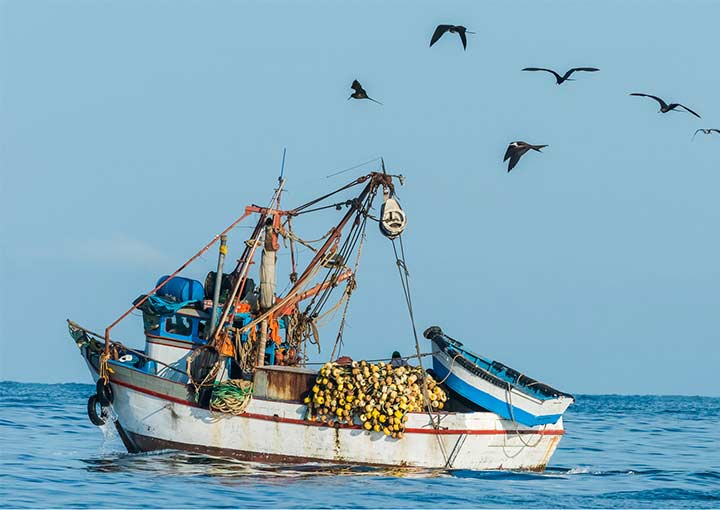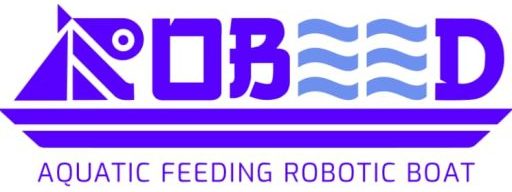
fish feeding boats
Fish farming is highly developmental as the primary source of food for humans’ considerable potential in the fishing industry, significantly that must be increased production. The process of feeding fish cannot be separated from the increase in fisheries production. Feeding is a key factor in determining the effectiveness and cost of fish feed. In order to maximize its efficiency, it is important to be able to determine when meals are no longer needed.
Fish farmers face a challenge in ensuring that fish are properly fed. Economic losses such as wasted food, which may negatively affect water quality and contribute to pollution of waters should be avoided with the correct amount of food. in addition, other studies showed that overpopulation is causing feed waste, low water quality, and reduced economic benefits as well as further pollution of the environment which leads to increased fish mortality. Whereas good water conditions are a process to ensure the quality of water environment and ecology of fish productivity cultivation to be high.
It is very difficult to feed fish, particularly in big ponds that cover a large area of land. Only fish feed by the lake may be fed in larger ponds with human labor, which means that there is not a consistent distribution of their food into the middle of the pond. Farmers have to walk around a large pond by approaching hordes of fish while feeding manually, it is very ineffective and draining. In order to increase the efficiency of fish feeds, it is important to develop devices that automatically feed fish. The development of simple mechanical feed devices became a necessity in semi-intensive and intensive aquaculture systems. some research results report various types of automatic fish feed tools to overcome the problems of fish feeding, feeders, and monitoring feed consumption.
Feeding equipment
Feeding carts
In the case of intensive fish farming, with centralized pond systems connected to suitable roads, feeding carts can be used effectively. They are not automatically operated, but the operator is fully in control of them. The feeding machines can be driven by themselves or tractors. This feeding cart’s basic operation principle is the same. feed shall be blown into a fish tank via turbo blowers or large capacity ventilators.
A tractor-pulled feeding cart that is operated by an individual gasoline engine and can be controlled from the tractor by an electric remote-control panel. A self-propelled feeding cart where the feed distribution and portioning can be controlled by a mechanical transmission.
Feeding boats
In fish farms having large ponds, feeding boats can be used efficiently. There is a longitudinal slot in the bottom of these boats through which the feed grain is washed out by water current during the movement of the boat these boats can also be used for fertilization of fish ponds. They are, however, not suitable for applying pelleted feed because the feed swells up in the bottom of the boat and cannot flow out through the slot. In order to make these boats suitable for feeding pellet a pellet-distributing adapter can be mounted on top of the conventional boat. there are feeding boats that are specially designed for fish farms both for pellet and feed grain distribution. One of these types of feeding boats is where the feed is discharged from the containers by screws driven by a paddle wheel that rotates during the movement of the boat. Fish feeding boats, also known as fish feeders or fish farming vessels, are specialized watercraft designed to aid in the feeding of fish in aquaculture farms. here are some different types of fish feeding boats:
Automatic feeders:
These boats are equipped with automatic feeding systems that dispense fish feed at predetermined intervals. the feed is stored in a hopper and released into the water through a pipe or chute.
Hand-fed boats:
These boats require manual labor for feeding the fish. Workers distribute the feed from the boat by hand, either by scattering it over the water’s surface or using a specialized feeder that propels the feed underwater.
Remote-controlled feeders:
These boats use remote control technology to operate the feeding system. This allows operators to adjust the amount and frequency of feed delivered to the fish.
Barge-mounted feeders:
These boats are mounted on barges that can hold large amounts of feed and transport it to multiple feeding locations within a farm. they are often used in larger-scale operations where efficiency and speed are critical.
Catamaran feeders:
These boats have a twin-hull design that provides greater stability and maneuverability when navigating through crowded fish pens. They can be outfitted with various feeding systems, including automated and remote-controlled options.
Smart boat robot (Robbed):
This smart boat is made in different sizes and can move intelligently in fish breeding ponds. It feeds fishes in certain amounts at specific times. According to the defined program, the electricity is provided through the solar panel. Movement of this boat is with the help of an intelligent system. Also, the feeding system of this boat works by adjusting the engine speed and rotating sparing blades.
With the help of the control system and program written for this boat and the mechanized system of food-spraying blades and solar panels installed, it turns on automatically 24 hours a day on fish breeding ponds, etc. The food tank and its size are changeable. The control system installed is adjusted for different times and conditions for food.
The innovative part
1- Intelligent and adjustable blade system with a special angle for food distribution
2- Control system and programmed board for 12-volt power consumption and boat control system 3-designing a special body for placing equipment with the same balance on the water.
Special features
Reducing fish farming costs
Increased productivity
Reducing physical labor
Programmability
Portable
Lightweight
Waterproof
The smart boat’s advanced features set it apart from other boats, making it a superior choice for those who value convenience, safety, and environmental sustainability.
In summary, fish feeding boats come in many shapes and sizes, each designed to meet the unique needs of aquaculture farms. from automatic feeders to barge-mounted systems, these boats play a vital role in ensuring the health and growth of farmed fish.
Fish feeding boats application
Automatic fish feeding boats have several applications in aquaculture, including:
- Large-scale fish farms: In large fish farms, manual feeding can be time-consuming and labor-intensive. Automatic fish feeding boats can help improve efficiency by delivering feed quickly and evenly over the area of the farm.
- Offshore fish farming: In offshore aquaculture systems, automatic fish feeding boats can be used to deliver feed to fish in cages or pens that are located far from shore. This can help reduce the costs associated with transporting feed and the need for workers to travel long distances.
- Hatcheries: Automatic fish feeding boats can also be used in hatcheries, where they can deliver precise amounts of feed to young fish. This can help optimize growth and reduce waste.
- Research facilities: Fish feeding boats can be used in research facilities to deliver feed to study participants at precise intervals and in precise amounts, helping to ensure consistent conditions for experiments.
Overall, automatic fish feeding boats can help improve the efficiency and precision of feeding operations in a variety of aquaculture settings, resulting in improved fish growth rates, reduced costs, and increased productivity.
Benefits of fish feeding boats
There are several benefits of using fish feeding boats in aquaculture, including:
- Increased efficiency: Fish feeding boats can cover a larger area and deliver feed to fish at a faster rate than hand feeding, which can save time and increase productivity.
- Better feed distribution: The use of a fish feeding boat ensures that fish receive an even distribution of feed throughout the pond or cage, reducing waste and promoting better growth.
- Reduced labor costs: With the use of a fish feeding boat, fewer workers are needed to distribute feed manually, which can result in cost savings for the farm.
- Improved safety: Feeding fish from a boat can be safer for workers, as they are not required to wade into the water to distribute feed.
- More precise feeding control: Many modern fish feeding boats come equipped with advanced monitoring technology, allowing farmers to precisely control the amount of feed delivered to fish, which can help optimize growth and reduce waste.
Overall, fish feeding boats can help improve the efficiency, effectiveness, and safety of aquaculture operations.
Conclusion
In conclusion, while there are various types of fish feeding boats available in the market, it is clear that the use of “smart” fish feeding boats offers numerous benefits and advantages over traditional models. The incorporation of advanced technologies such as automation, machine learning, and real-time monitoring allows for more efficient and precise feeding of fish in aquaculture farms, resulting in healthier fish populations, increased productivity, and reduced costs. Thus, it is clear that investing in smart fish feeding boats is a wise decision for those looking to improve their aquaculture operations.

